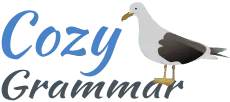
This month we wanted to share two video excerpts about verbs from Lesson 7 of The Basic Cozy Grammar Course.
In this first video excerpt, Marie introduces three things that verbs express—action, possession, and existence—and gives us four examples of verbs of action.
I love this clip because it shows how Marie uses memorable examples around her cozy beach cottage to illustrate a grammatical concept.
As people become familiar with such concepts, however, they often wonder how these ideas relate to life. How does knowing that something is a verb help, for instance, with writing?
Our second video excerpt this month addresses this question directly. In Marie's Study Notes for Lesson 7, you'll find an additional video in which I show how verbs of action can be among a writer's most powerful tools:
Marie's Study Notes for each lesson give students several ways to continue exploring and expanding their understanding.
Her notes for Lesson 7, for instance, also include exercises for identifying all three kinds of verbs in Shakespeare, to be done whenever a student becomes interested. Marie saw grammar as a doorway to the wider world of both literature and experience.
In that spirit, I wanted to share one more example of the power of verbs of action.
The Power of a Dream
Take a look at this poem by Langston Hughes:
Harlem
What happens to a dream deferred?
Does it dry up
like a raisin in the sun?
Or fester like a sore—
And then run?
Does it stink like rotten meat?
Or crust and sugar over—
like a syrupy sweet?
Maybe it just sags
like a heavy load.
Or does it explode?
(You can explore this and other poems by Langston Hughes on the Poetry Foundation website.)
Now look at the kinds of verbs that the poem uses. Do you notice anything interesting?
Every verb in this poem—happens, dry up, fester, run, stink, crust, sugar over, sags, and explode—is a verb of action. That's part of why the poem is so vivid and powerful.
An Invitation to Action
Both William Shakespeare and Langston Hughes understood the power of verbs of action. They demonstrate in their work how knowledge of grammar can enhance our ability to write more vividly and more actively.
But don't take my word for it, or even theirs. Try the creative writing activity in the second video excerpt and see for yourself!
One of the best ways to discover how language and grammar actually work is to apply what you've learned in playful and creative ways.
And if you happen to discover something interesting in the process, I invite you to send us what you write. We'd love to see your writing, and might even share an excerpt in a future Cozy Grammar newsletter.
An Announcement about Tracking Progress
With the opening of the new Cozy Grammar website, we've received a few questions about the possibility of tracking course progress and printing the results of exercises for documentation.
I'm pleased to announce that we are currently in the process of adding these features. Soon you'll be able to track your progress through all of our courses, access a record of how you did on the exercises, and print an official course completion certificate.
Watch for a complete update in next month's newsletter.
Thank you for joining us this month. If you know anyone who would be interested in free excerpts, grammar tips, and creative writing activities from Marie and myself, please feel free to pass along our newsletter.
See you again next month!

Warmly,
Thomas
Marie's Language Consultant
The Cozy Grammar Series of Courses
